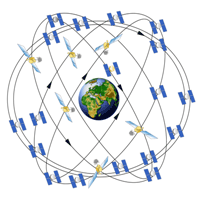
With final passage of the Omnibus spending bill on December 13 Congress deepened by $17 million the fiscal ditch in which the new GPS ground system finds itself, possibly further delaying the completion of a modernized operational control segment (OCX) and increasing costs just as the Department of Defense’s top acquisition official steps in to take a closer look at budget overruns.
With final passage of the Omnibus spending bill on December 13 Congress deepened by $17 million the fiscal ditch in which the new GPS ground system finds itself, possibly further delaying the completion of a modernized operational control segment (OCX) and increasing costs just as the Department of Defense’s top acquisition official steps in to take a closer look at budget overruns.
Though $17 million is a relatively small amount of money, the reduction to $10 million in the White House’s $27-million request for civil GPS features is the fifth cut in a row for the civil contribution to OCX, which is being developed by a team led by Raytheon Corporation. The White House directed that the civil community, through the Federal Aviation Administration, contribute to the costs of the GPS program to give them both a voice and a stake in the program. The money is supposed to go to OCX to support monitoring of the new non-military signals.
But Congress has cut civil funding every year since 2010, leaving the FAA $100 million to $150 million behind on its required contribution.
Meanwhile, technical problems have caused the cost of the OCX program to soar from $866 million in 2010 to $1.6 billion according to Reuters, who cited Air Force officials. The primary reason for increase is the complexity of the information assurance component, said Gen. John Hyten, commander of Air Force Space Command. He spoke to reporters after giving a speech at an Air Force Association Mitchell Institute seminar on December 5.
But the civil funding cut for fiscal year 2015, if it ultimately delays the program, will itself drive program costs even higher, said Col. Bill Cooley, director of the Global Positioning System (GPS) Directorate.
“I don’t want to slip OCX because Congress does not appropriate money for the civils to pay their bill,” he said, ” And that’s where we’re at — because it will basically be almost three for one,” he told Inside GNSS. “It will cost me three times as much to pay for everything that I don’t get appropriated from the civil funding.”
The sharp cost increase results from delays to the program.
“If I can’t do the development work this year, I’m going to have to push that (out) — I’m going to slow everything down and add work on the back end potentially,” extending the overheard and level-of-effort charges in the process, he told Inside GNSS. “It’s a very inefficient way to do development.”
Review of Program Planned
The cuts came just a week after the Pentagon acknowledged that it planned to closely scrutinize the already behind-schedule and over-budget OCX program.
Frank Kendall, the undersecretary of defense for acquisition, technology and logistics, will do a “deep dive” review of the OCX program in January, Pentagon spokesman Maureen Schumann told Inside GNSS.
“Mr. Kendall and the acquisition folks are looking at the program,” acknowledged Hyten, “and trying to figure out if we’re doing the right thing; if we need to adjust it.”
The goal for OCX, Hyten said, is to get to automate the actual management of the system and shift the constellation operators to “effects-based operations.” They will then focus on using their satellite and signal expertise to help warfighters solve specific problems such as getting supplies to the right air drop location despite the GPS signal being blocked by mountainous terrain.
“That was the vision for the next generation ground system from the very beginning,“ Hyten explained.
To provide that kind of service, however, the Air Force needs Raytheon to come through, he said. “We need OCX. We need a new command-and-control system.”
To address the difficulties with meeting the information assurance requirements the Air Force restructured the OCX program this fall, officially pushing final completion out about 2 years. The company is now expected to deliver the OCX Launch and Checkout System (Block 0) by November 30, 2015, said a Space and Missile Systems Center spokesperson. Block 1 is to be delivered by May 31, 2018, and Block 2 a year later. The contract for Block 2 has yet to be finalized.
Cooley told the National Space-Based Positioning, Navigation, and Timing (PNT) Advisory Board on December 10 that he expected to transition to OCS Block 1 in 2019. The civil signal monitoring capability that the civil money supports is part of Block 2 and should be operational in 2020.
He told Inside GNSS he is looking for ways to avoid having the civil funding cuts slow the program any further.
Fortunately problems caused to the slippage of the ground system have been ameliorated somewhat by delays in the GPS III satellite program led by prime contractor Lockheed Martin. That effort has been hampered by technical problems with the new satellite’s navigation payload. Program managers became so frustrated that they now are weighing recompeting the later part of the GPS III acquisition contract.





